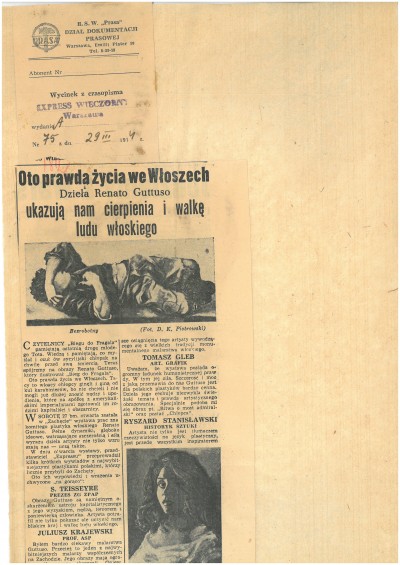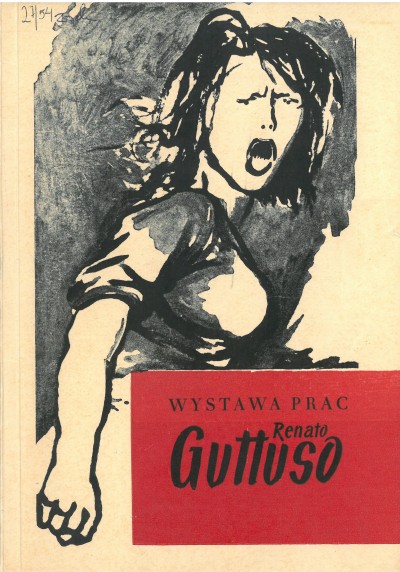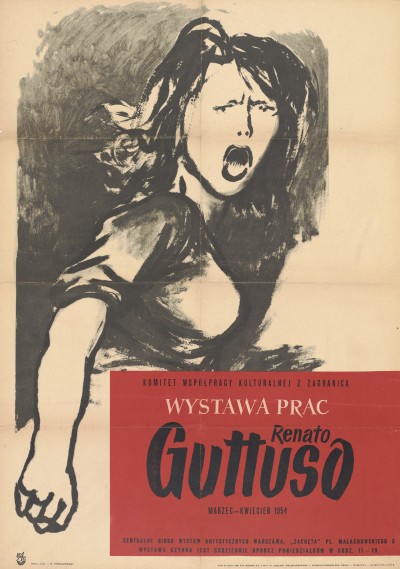Renato Guttuso Painting, drawing
27.03 – 01.04.1954 Renato Guttuso Painting, drawing
Zachęta Central Bureau of Art Exhibitions (CBWA)
organiser: Committee for Cultural Cooperation with Foreign Countries, Central Bureau of Art Exhibitions
attendance: 18,556
The exhibition of 46 works by Renato Guttuso (1911–1987), consisting of 30 paintings and 16 drawings, occupied two big rooms at Zachęta. A poster advertising the show reproduced one of the pieces, The Fighter, a strongly expressive work of art which brings to mind The Bomber (2004), the contemporary sculpture of Anna Baumgart. Guttuso was a member of the Central Committee of the Communist Party of Italy (since 1951), the World Peace Council, and a former partisan. He came from the ‘Corrente’ Milanese group, which at the time of the exhibition in Zachęta was gathered around the magazine Realismo and also comprised Armando Pizzinato, Aldo Borgonzoni and Ernesto Treccani.[1] This was probably the reason why the exhibition was presented in the majority of the countries under people’s democratic rule. First, it travelled from Prague to Warsaw, and afterwards it visited Budapest, Bucharest and Sofia.[2] In 1948, Guttuso received an award at the Venice Biennale; however, as Katarzyna Murawska-Muthesius claims, he was not popular in the 1950s in Western Europe or the United States, because his art did not conform to the conventions of fashionable modernism. Nevertheless, the artist was very well received in the countries behind the Iron Curtain.[3]
Guttuso’s works shown at the Central Bureau of Art Exhibitions came from 1952–1954, except for the Battle of the Bridge of the Admiral. Among other things, one still life and several landscapes were put on display. Daniel Trylewicz observed, ‘The subject of the remaining pictures is a simple man, a farm worker occupying fallow landed estate, a striker, wives of miners, Sicilian peasants’.[4] Karol Eberhardt aptly described Guttuso’s creative output as ‘violent and colourful art’.[5] The above-mentioned picture, Battle of the Bridge of the Admiral (1951–1952), a depiction of the struggle for liberation led by Garibaldi, measuring over 16 square metres, drew particular attention. Eberhardt traced the allusions in the painting to The Battle of Anghiari by Leonardo da Vinci and Guernica by Pablo Picasso.[6] Moreover, Guttuso was compared with Francisco Goya, Honoré Daumier and Eugène Delacroix; references to Michelangelo Merisi da Caravaggio were also noticed.
Battle of the Bridge of the Admiral is considered to be the beginning of the realistic period in Guttuso’s painting. It was stressed in the press that ‘between 1948 and 1952, the artist made a radical turn toward mature realism’.[7] It should be emphasised that Guttuso had a French counterpart, André Fougeron, whose picture Parisians at the Market, painted in 1948,[8] secured him a place among French Socialist Realists. As with Fougeron, Guttuso ‘only after the war freed himself from the influences of cubism and expressionism, and started treating formal problems exclusively as a function of content’.[9]
The exhibition’s reviews were full of Socialist-Realist newspeak. In Nowa Kultura, Guttuso was described as a ‘passionate agitator who exposes the bourgeois world and reveals the true nature of Italy governed by the Christian Democratic Party.[10] A tone of propaganda could also be found in Stolica, but here, it was not devoid of criticism: ‘Being at another stage of the development of realist art and having seen the crowning achievements of realist Soviet painting in the same exhibition halls of “Zachęta” several times, we can be surprised by excessive garishness, deformations and other formalist influences in Guttuso’s paintings’.[11] Ignacy Witz likewise spotted the artist’s technical shortcomings: ‘Guttuso sometimes goes to extremes to gain greater power of expression, cannot avoid a dissonance of colours, and his artistic techniques are often imperfect’.[12]
However, other voices were harbingers of inevitable changes in cultural policy. The exhibition took place in 1954, when Polish artistic life already sensed the approaching thaw. At that time, artists started to abandon the aesthetics of Socialist Realism and resumed the post-war discussion about diverse forms of realism. In 1954, Juliusz Starzyński wrote about a ‘broadly understood tradition’ which allows artists to draw on the experiences of the Impressionists and Picasso, whose art owed its realism to the sincerity of the feelings expressed in it.[13]
The Colourist Eugeniusz Eibisch, claiming that he was a close friend of Guttuso, noticed in the paintings of the Italian painter a colour which ‘is more a symbol than a way of seeing the world’.[14] Moreover, Sztandar Młodych voiced the opinion that ‘the exhibition in Zachęta shows us Renato Guttuso as a painter who can use colour perfectly’.[15] Tomasz Gleb focused on the freshness of this artistic approach for Polish artists: ‘The sincerity and power of Guttuso’s expression proves highly valuable for Polish visual artists. His works are characterised by exceptional novelty of the subject and the verity of artistic imagery’.[16] Others held Guttuso as an example for Polish artists as well: ‘It is with regret that we recall the pictures of our realist painters, the dirty colours of their canvases, the stillness of depicted scenes, and boredom’.[17] Hanna Szczypińska added, ‘I find it positive that our usually careful realism gets into confrontation with such an intense creative passion, fierceness of experiments, boldness of attempts which are made even at the cost of temporary mistakes and blunders’.[18] The words of Jan Kowalski appear the most interesting: ‘We haven’t seen such panache, such vibrancy, such topical bluntness in Polish painting before. Such spontaneity is new to us. Our visual arts are almost always boring and schematic . . . Polish art, even though it has ample opportunities for development as well as the political and financial backing of the government, generally settles for cold and affected kitsch.’
Polish artists learned the lesson taught by Guttuso. His influence on Andrzej Wróblewski’s paintings was clearly visible.[19] The Guttuso exhibition left an impact on the works presented at the Against War, Against Fascism Polish National Exhibition of Young Visual Arts mounted at Warsaw’s Arsenal in 1955 and treated as a rebellion against the programme of Socialist Realism dominating in Polish art. Jakub Dąbrowski indicates Jan Dziędziora as a painter drawing inspiration from Guttuso at that time.[20]
Guttuso had already been known in Poland before.[21] In 1948, he was a member of the board of the World Congress of Intellectuals in Defence for Peace in Wrocław.[22] In 1952, the Polish government awarded the artist the State Artistic Prize[23] for his illustrations for a book by Julian Stryjkowski, Bieg do Fragalà.[24] In 1953, he showed his works at the exhibition of Italian prints. Before the show in Zachęta, his artistic output and texts were often published in Przegląd Artystyczny. In 1950, the article ’Artysta bojownikiem pokoju’[25] came out, and in 1954 — ‘Na drodze do realizmu’[26] and ‘Jarmark snobizmu (w związku z XXVII Biennale)’.[27]
In the 1950s, Italian culture was, for Poles, almost equally important as French culture. In Italy, like in France, the communist party held a strong position, and therefore the culture of these two countries was widely available in people’s democracies. The period of the popularity of Italian film falls in those years, too (Miracle in Milan,[28] Bicycle Thieves,[29] Rome 11:00[30]). The similarities between the poetics of Italian film of that time and Guttuso’s pictures were recognised. The film critic Konrad Eberhardt saw ‘a common feature just in this “poetry”, in turning ordinary things, normal scenes, everyday events into a symbol, in this tendency to use powerful metaphors which contemporary Italian realists can discover in their mundane reality.’[31]
One of Guttuso’s paintings, Calabrians at the Piazza di Spagna (1952), purchased by the Polish government after the exhibition,[32] was placed in the warehouse of the National Museum in Warsaw and not shown until 2007. Katarzyna Murawska-Muthesius suggests that its rediscovery was a result of her paper ’How the West Corroborated Socialist Realism in the East: Fougeron, Taslitzky and Picasso in Warsaw’, in which she wrote about the unearthing of some Western communists’ works stored in the warehouse of the National Museum in Warsaw since the 1950s.[33]
The Guttuso exhibition was also staged in the Youth Palace in Kraków (22 May–7 June) and in Lublin Castle. It seems worth looking into the report of the Lublin part of the show because it describes a typically socialist realist display of artworks: ‘So in the first exhibition hall, in which simultaneously there was a strong decorative accent and flags, such pictures as the Death of a Hero, Greece 1952, Occupation of Uncultivated Lands of Sicily, The Women of the Sulphur Miners, The Wives of Striking miners and The Unemployed were hung . . . All the halls were adorned with cut flowers and bushes in flowerpots.’[34]
Karolina Zychowicz
documentation department of Zachęta — National Gallery of Art
This compilation was prepared as part of the National Programme for the Development of Humanities of the Polish Minister of Science and Higher Education — research project The History of Exhibitions at Zachęta — Central Bureau of Art Exhibitions in 1949–1970 (no. 0086/NPRH3/H11/82/2016) conducted by the Institute of Art History of the University of Warsaw in collaboration with Zachęta — National Gallery of Art.
Bibliography
Compilations:
- Kal, Elżbieta. „Tego się nie krytykuje, na kogo się nie liczy”. Polska krytyka artystyczna okresu realizmu socjalistycznego. Słupsk, 2010
- Murawska-Muthesius, Katarzyna. ‘Remapping Socialist Realism: Renato Guttuso in Poland’, in Jérôme Bazin, Pascal Dubourg Glatigny, Piotr Piotrowski, eds., Art beyond Borders. Artistic Exchange in Communist Europe [1945–1989]. Budapest and New York, 2016, pp. 139–150
- Zychowicz, Karolina. The Exhibition-Organising Activity of the Comitee for Cultural Cooperation with Foreign Countries (1950–1956) Based on the Example of Selected Exhibitions at the Zachęta Central Bureau of Art Exhibitions, trans. Klaudyna Michałowicz. Ikonotheka, no. 26, 2016, pp. 63–94
Source texts:
- Borowiak, Barbara. ‘Renato Guttuso’. Świetlica, no. 5, 1954
- Czartkowska-Jeżewska, Z. ‘Wystawa Renato Guttuso’. Tygodnik Demokratyczny, no. 15, 1954, p. 8
- Ćwiertnia, Jerzy. ‘Guttuso’. Po Prostu, no. 15, 1954, p. 4
- ‘Dwie wystawy w Zachęcie’. Stolica, no. 17, 1954
- Eberhardt, Karol. ‘O sztuce gwałtownej i barwnej’. Dziś i Jutro, no. 15, 1954
- Gont. ‘Postępowa sztuka włoska oskarża’. Zielony Sztandar, no. 17, 1954
- ‘Guttuso’. Nowa Kultura, no. 13, 1954
- ‘Guttuso w „Zachęcie”’. Życie Warszawy, no. 87, 1954
- J. O. ‘Renato Guttuso — malarz rewolucyjnych Włoch’. Sztandar Młodych, no. 78, 1954
- Kowalski, Jan. ‘Szkoła odwagi (Refleksje na marginesie wystawy Guttusa)’. Dziś i Jutro, no. 19, 1954
- Lubosz, Bolesław. ‘Ami go home! — po malarsku’. Trybuna Robotnicza, no. 96, 1954
- ‘Oto prawda życia we Włoszech. Dzieła Renato Guttuso ukazują nam cierpienia i walkę ludu włoskiego’. Express Wieczorny, no. 75, 1954
- ‘Renato Guttuso’. Gazeta Białostocka, no. 79, 1954
- ‘Renato Guttuso’, in Wystawa prac Renato Guttuso, kwiecień 1954, exh. cat. Warsaw: Centralne Biuro Wystaw Artystycznych, 1954, pp. 7–8
- ‘Renato Guttuso — artysta walki’, Żołnierz Polski, no. 9, 1954
- ‘Renato Guttuso malarz włoskiego proletariatu’. Słowo Powszechne, no. 75, 1954
- ‘Renato Guttuso w Polsce’. Dziś i Jutro, no. 9, 1954
- Stanisławski, Ryszard. ‘Guttuso — malarz ludu włoskiego (z wystawy prac artysty w Zachęcie)’. Przegląd Artystyczny, no. 3, 1954, pp. 46–53
- Stanisławski, Ryszard. ‘Wstęp’, in Wystawa prac Renato Guttuso, kwiecień 1954, exh. cat. Warsaw: Centralne Biuro Wystaw Artystycznych, 1954, pp. 3–5
- Szczawińska, Hanna. ‘Guttuso’. Tygodnik Powszechny, no. 19, 1954
- Szeląg, Jan. [untitled]. Świat, no. 15, 1954
- Trylewicz, Daniel. ‘Guttuso’. Nowiny Tygodnia, no. 13, 1954, p. 1
- Trylewicz, Daniel. ‘Renato Guttuso’. Głos Wybrzeża, no. 80, 1954; Gazeta Pomorska (Bydgoszcz), no. 83, 1954; Nowiny Rzeszowskie, no. 85, 1954; Trybuna Mazowiecka, no. 86, 1954; Trybuna Opolska, no. 96, 1954
- ‘Uwagi o twórczości Renato Guttuso (wg pracy A. Trombadori)’, in Wystawa prac Renato Guttuso, kwiecień 1954, exh. cat. Warsaw: Centralne Biuro Wystaw Artystycznych, 1954, pp. 9–18
- Vetulani, Armand. ‘Wystawa prac Renato Guttuso’. Przegląd Kulturalny, no. 14, 1954
- ‘W salach „Zachęty” otwarto wystawę prac Renato Guttuso’. Ilustrowany Kurier Polski (Bydgoszcz), no. 74, 1954
- Witz, Ignacy. ‘Renato Guttuso artysta prawdy i walki’. Życie Warszawy, no. 87, 1954
- ‘Wystawa prac Renato Guttuso’. Trybuna Ludu, no. 87, 1954
- ‘Wystawa prac Renato Guttuso’. Życie Literackie, no. 14, 1954
- ‘Z wystawy prac Renato Guttuso w „Zachęcie” w Warszawie’. Gazeta Zielonogórska, no. 80, 1954
- ‘Z wystawy prac Renato Guttuso’. Ilustrowany Kurier Polski, no. 86, 1954
- ‘Wystawa Renato Guttuso’. Tygodnik Demokratyczny, no. 14, 1954
- ‘Wystawa Renato Guttuso w Warszawie’. Dziś i Jutro, no. 14, 1954
Press mentions:
- Gazeta Poznańska, no. 79, 1954
- Głos Robotniczy (Łódź), no. 78, 1954
- Kurier Szczeciński, no. 75, 1954
[1] Konrad Eberhardt, ‘O sztuce gwałtownej i barwnej’, Dziś i Jutro, no. 15, 11 April 1954.
[2] Katarzyna Murawska-Muthesius, ‘Remapping Socialist Realism: Renato Guttuso in Poland’, in Art beyond Borders. Artistic Exchange in Communist Europe [1945–1989], ed. Jérôme Bazin, Pascal Dubourg Glatigny, Piotr Piotrowski, Budapest and New York, 2016, p. 148.
[3] Ibid., p. 142.
[4] Daniel Trylewicz, ‘Renato Guttuso’, Głos Wybrzeża, no. 80, 1954.
[5] Eberhardt.
[6] Ibid.
[7] J. O., ‘Renato Guttuso — malarz rewolucyjnych Włoch’, Sztandar Młodych, no. 78, 1 April 1954.
[8] Cf. Karolina Zychowicz, Paryska lewica w stalinowskiej Warszawie. Wystawa współczesnej plastyki francuskiej w CBWA w 1952 roku, Warsaw: Zachęta — Narodowa Galeria Sztuki, 2014, pp. 62–63.
[9] Trylewicz.
[10] ‘Guttuso’, Nowa Kultura, no. 13, 28 March 1954.
[11] ‘Dwie wystawy w Zachęcie’, Stolica, no. 17, 25 April 1954.
[12] Ignacy Witz, ‘Renato Guttoso — artysta prawdy i walki’, Życie Warszawy, no. 87, 11–12 April 1954.
[13] Juliusz Starzyński, ‘Od Courbeta do Picassa, czyli o perspektywach sztuki nowoczesnej’, Materiały do Studiów i Dyskusji, no. 3/4, 1954, p. 27. Cf. Karolina Zychowicz, ‘Koncepcje realizmu w polskiej krytyce artystycznej lat 1945–1955’, Studia i Materiały Lubelskie, no. 20, 2017, pp. 24–35.
[14] ‘Oto prawda życia we Włoszech. Dzieła Renato Guttuso ukazują nam cierpienia i walkę ludu włoskiego’, Express Wieczorny, no. 75, 24 March 1954.
[15] J. O., ‘Renato Guttuso — malarz rewolucyjnych Włoch’, Sztandar Młodych, no. 78, 1 April 1954.
[16] ‘Oto prawda życia we Włoszech’.
[17] Eberhardt.
[18] Hanna Szczypińska, ‘Guttuso’, Tygodnik Powszechny, no. 19, 1954.
[19] Murawska-Muthesius, p. 149; Katarzyna Nowakowska-Sito, Przewodnik. Galeria Sztuki XX wieku 1945–1955, Warsaw: Muzeum Narodowe w Warszawie, 2007, p. 50; Joanna Kordjak-Piotrowska, Andrzej Wróblewski 1927–1957. W setną rocznicę śmierci artysty, exh. cat., Warsaw: Muzeum Narodowe w Warszawie, 2007.
[20] Jakub Dąbrowski, ‘Recepcje Arsenału, czyli co recypowali „arsenałowcy”’, in ‘Recepcja Arsenału’. Sympozjum naukowe z okazji 60. rocznicy Ogólnopolskiej Wystawy Młodej Plastyki w Arsenale. Gorzów Wielkopolski, 12 czerwca 2015 roku, http://www.muzeumlubuskie.pl/attachments/648_RecepcjaArsenalu.pdf, p. 31 (accessed 21.02. 2016).
[21] Cf. J. L., ‘Twórczość Renato Guttuso’, Nowa Kultura, no. 10, 1952, p. 12; Janina Kowadłowska, ‘Renato Guttuso’, Nowa Kultura, no. 1, 1952, p. 7; ‘Renato Guttuso’, Przegląd Artystyczny, no. 4, 1952, p. 61; T. Zakrzewska, ‘Renato Guttuso’, Widnokrąg, no. 32, 1952, p. 3.
[22] Cf. Katarzyna Murawska-Muthesius, ‘Modernism between Peace and Freedom: Picasso and Others at the Congress of Intellectuals in Wrocław’, in Cold War Modern: Design 1945–1970, ed. David Crowley, Jane Pavitt, exh. cat., London: Victoria & Albert Museum, 2008, pp. 33–41.
[23] ‘Guttuso’, Nowa Kultura, no. 13, 28 March 1954.
[24] Julian Stryjkowski, Bieg do Fragalà, Warsaw, 1951, vol. 1–2.
[25] Renato Guttuso, ‘Artysta bojownikiem pokoju’, Przegląd Artystyczny, no. 7/9, 1950, p. 12.
[26] Renato Guttuso, ‘Na drodze do realizmu’, Przegląd Artystyczny, no. 4, 1954, pp. 52–60.
[27] Renato Guttuso, ‘Jarmark snobizmu (w związku z XXVII Biennale w Wenecji)’, Przegląd Artystyczny, no. 5/6, 1954, pp. 31–42.
[28] 1951, dir. Vittorio de Sica.
[29] 1948, dir. Vittorio de Sica.
[30] 1952, dir. Giuseppe de Santis.
[31] Eberhardt. The similarities were also noticed by Jan Szeląg, ‘Nasza kronika’, Świat, no. 15, 11 April 1954.
[32] Murawska-Muthesius, ‘Remapping Socialist Realism . . . ’, p. 148.
[33] Ibid., p. 141; Katarzyna Murawska-Muthesius, ‘How the West Corroborated Socialist Realism in the East: Fougeron, Taslitzky and Picasso in Warsaw’, Biuletyn Historii Sztuki, no. 2, 2003, pp. 303–329.
[34] Irena Iskrzycka, Sprawozdanie z organizacji wystawy prac Renato Guttuso, KWKZ [Committee for Cultural Cooperation with Foreign Countries] files, file no. 271, p. 2.
Renato Guttuso
Painting, drawing
27.03 – 01.04.1954
Zachęta Central Bureau of Art Exhibitions (CBWA)
pl. Małachowskiego 3, 00-916 Warsaw
See on the map



